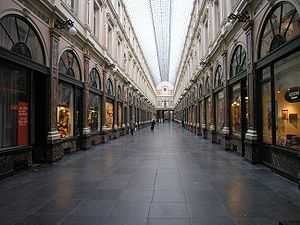Galeries Royales Saint-Hubert

The Galeries Royales Saint-Hubert (French) or Koninklijke Sint-Hubertusgalerijen (Dutch) is a glazed shopping arcade in Brussels that preceded other famous 19th-century shopping arcades such as the Galleria Vittorio Emanuele II in Milan and The Passage in St Petersburg. Like them it has twin regular façades with distant origins in Vasari's long narrow street-like courtyard of the Uffizi, Florence, with glazed arcaded shopfronts separated by pilasters and two upper floors, all in an Italianate Cinquecento style, under an arched glass-paned roof with a delicate cast-iron framework.
Architecture

The gallery consists of two major sections, each more than 100 meters in length (respectively called Galerie du Roi / Koningsgalerij, meaning King's Gallery, and Galerie de la Reine / Koninginnegalerij, meaning Queen's Gallery), and a smaller side gallery (Galerie des Princes / Prinsengalerij, meaning Gallery of the Princes). The main sections (King and Queen's Gallery) are separated by a colonnade at the point where the Rue des Bouchers / Beenhouwersstraat crosses the gallery complex.
At this point there is a discontinuity in the straight perspective of the gallery. This "bend" was introduced purposefully in order to make the long perspective of the gallery, with its repetition of arches, pilasters and windows, less tedious.
History
The gallery was designed by the young architect Jean-Pierre Cluysenaer, who determined to sweep away a warren of ill-lit alleyways between the Grasmarkt / Marché aux Herbes and the Kruidtuinberg / Montagne aux Herbes Potagères and replace a sordid space where the bourgeoisie scarcely ventured into with a covered shopping arcade more than 200 m in length. His idea, conceived in 1836, was finally authorized in February 1845. The partnership "Société des Galeries Saint-Hubert", in which the banker Jean-André Demot took an interest, was established by the summer, but nine years were required to disentangle all the property rights, assembled by rights of eminent domain, during a process that caused one property owner to die of a stroke and a barber, it was said, slit his throat as the adjacent house came down.
Construction started on May 6, 1846. It lasted for 18 months, and the 213 m passage was inaugurated on June 20, 1847 by King Leopold and his two sons. In 1845 the Société named the three sections of the new passage the Galerie du Roi, Galerie de la Reine and Galerie du Prince. The ensemble, called the Passage Saint-Hubert has borne its present name since 1965.
Under its motto "Omnibus omnia" (Everything for everybody), displayed in the fronton of its palace-like façade, the Passage Saint-Hubert attracted people of fashion. Brilliantly lit, it offered the luxury of outdoor cafés in Brussels' inclement climate, in an ambiance of luxury retailers that brought to Brussels the true feel of a European capital. In the premises of the journal, March 1, 1896, the first public showing of moving pictures took place of the cinematographers Lumière, fresh from their initial triumph in Paris.
A theatre inside the galleries, the Théâtre des Galeries Saint-Hubert, was designed by Cluysenaer and opened June 7, 1847. It became one of three royal theaters of Brussels, playing operetta and revues. The interior was rebuilt in 1951.
References
- Galeries Royales Saint-Hubert An account filled with detail.
- Galeries Royales Saint-Hubert Discovery guide with high quality pictures of the Royal Galeries of Saint-Hubert.
- Panoramic photography virtual tour of the Galeries Royales Saint-Hubert
Gallery
-

-

-
_Galeries_Royales_St_Hurbert%2C_Brussels.jpg)
Galeries Royales St Hubert, Brussels
-
The small side Gallery of the Princes
External links
Coordinates: 50°50′51″N 4°21′17″E / 50.847483°N 4.354773°E
